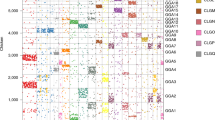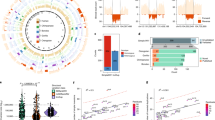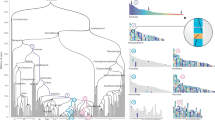Abstract
Initial human genome sequence analysis has revealed large segments of nearly identical sequence in particular chromosomal regions. The recent origin of these segments and their abundance (∼5%) has challenged investigators to elucidate their underlying mechanism and role in primate genome evolution. Although the precise fraction is unknown, some of these duplicated segments have recently been shown to be associated with rapid gene innovation and chromosomal rearrangement in the genomes of man and the great apes.
This is a preview of subscription content, access via your institution
Access options
Subscribe to this journal
Receive 12 print issues and online access
$189.00 per year
only $15.75 per issue
Buy this article
- Purchase on Springer Link
- Instant access to full article PDF
Prices may be subject to local taxes which are calculated during checkout





Similar content being viewed by others
References
Ohno, S. Evolution by Gene Duplication (Springer, New York, 1970).
White, T. D. J. Modes of Speciation (W. H. Freeman, San Francisco, California, 1973).
O'Brien, S. J. & Stanyon, R. Phylogenomics. Ancestral primate viewed. Nature 402, 365–366 (1999).
Lundin, L. Evolution of the vertebrate genome as reflected in paralogous chromosomal regions in man and the house mouse. Genomics 16, 1–19 (1993).
The International Human Genome Sequencing Consortium. Initial sequencing and analysis of the human genome. Nature 409, 860–921 (2001).
Venter, J. C. et al. The sequence of the human genome. Science 291, 1304–1351 (2001).
Cheung, V. G. et al. Integration of cytogenetic landmarks into the draft sequence of the human genome. The BAC Resource Consortium. Nature 409, 953–958 (2001).
Bailey, J. A., Yavor, A. M., Massa, H. F., Trask, B. J. & Eichler, E. E. Segmental duplications: organization and impact within the current human genome project assembly. Genome Res. 11, 1005–1017 (2001).
Eichler, E. E. Recent duplication, domain accretion and the dynamic mutation of the human genome. Trends Genet. 17, 661–669 (2001).
Eichler, E. E. et al. Duplication of a gene-rich cluster between 16p11.1 and Xq28: a novel pericentromeric-directed mechanism for paralogous genome evolution. Hum. Mol. Genet. 5, 899–912 (1996).
Horvath, J., Schwartz, S. & Eichler, E. The mosaic structure of a 2p11 pericentromeric segment: a strategy for characterizing complex regions of the human genome. Genome Res. 10, 839–852 (2000).
Tilford, C. A. et al. A physical map of the human Y chromosome. Nature 409, 943–945 (2001).
Dombroski, B. A., Mathias, S. L., Nanthakumar, E., Scott, A. F. & Kazazian, H. H. Jr. Isolation of an active human transposable element. Science 254, 1805–1808 (1991).
Moran, J. V., DeBerardinis, R. J. & Kazazian, H. H. Jr. Exon shuffling by L1 retrotransposition. Science 283, 1530–1534 (1999).
Hattori, M. et al. The DNA sequence of human chromosome 21. The chromosome 21 mapping and sequencing consortium. Nature 405, 311–319 (2000).
Adams, M. D. et al. The genome sequence of Drosophila melanogaster. Science 287, 2185–2195 (2000).
Copenhaver, G. P. et al. Genetic definition and sequence analysis of Arabidopsis centromeres. Science 286, 2468–2474 (1999).
Eichler, E., Archidiacono, N. & Rocchi, M. CAGGG repeats and the pericentromeric duplication of the hominoid genome. Genome Res. 9, 1048–1058 (1999).
Guy, J. et al. Genomic sequence and transcriptional profile of the boundary between pericentromeric satellites and genes on human chromosome arm 10q. Hum. Mol. Genet. 9, 2029–2042 (2000).
Davis, M., Kim, S. & Hood, L. DNA sequences mediating class switching in α-immunoglobulins. Science 209, 1360–1365 (1980).
Sen, D. & Gilbert, W. Formation of parallel four-stranded complexes by guanine-rich motifs in DNA and its implications in meiosis. Nature 334, 364–366 (1988).
Horvath, J. et al. Molecular structure and evolution of an α/non-α satellite junction at 16p11. Hum. Mol. Genet. 9, 113–123 (2000).
Jackson, M. S. et al. Sequences flanking the centromere of human chromosome 10 are a complex patchwork of arm-specific sequences, stable duplications, and unstable sequences with homologies to telomeric and other centromeric locations. Hum. Mol. Genet. 8, 205–215 (1999).
Bailey, J. A. et al. Human specific duplication and mosaic transcripts: the recent paralogous structure of chromosome 22. Am. J. Hum. Genet. 70 (in the press).
Keller, M. P., Seifried, B. A. & Chance, P. F. Molecular evolution of the CMT1A-REP region: a human- and chimpanzee-specific repeat. Mol. Biol. Evol. 16, 1019–1026 (1999).
Courseaux, A. & Nahon, J. L. Birth of two chimeric genes in the Hominidae lineage. Science 291, 1293–1297 (2001).
Lupski, J. R. Genomic disorders: structural features of the genome can lead to DNA rearrangements and human disease traits. Trends Genet. 14, 417–422 (1998).
Emanuel, B. S. & Shaikh, T. H. Segmental duplications: an 'expanding' role in genomic instability and disease. Nature Rev. Genet. 2, 791–800 (2001).
Osborne, L. R. et al. A 1.5 million-base pair inversion polymorphism in families with Williams–Beuren syndrome. Nature Genet. 29, 321–325 (2001).
Kuroda-Kawaguchi, T. et al. The AZFc region of the Y chromosome features massive palindromes and uniform recurrent deletions in infertile men. Nature Genet. 29, 279–286 (2001).
Yunis, J. J. & Prakash, O. The origin of man: a chromosomal pictorial legacy. Science 215, 1525–1530 (1982).
Turleau, C., De Grouchy, J. & Klein, M. Chromosomal phylogeny of man and the anthropomorphic primates (Pan troglodytes, Gorilla gorilla, Pongo pygmaeus). Attempt at reconstitution of the karyotype of the common ancestor. Ann. Genet. 15, 225–240 (1972).
Dutrillaux, B. Chromosomal evolution in primates: tentative phylogeny from Microcebus murinus (Prosimian) to man. Hum. Genet. 48, 251–314 (1979).
Nickerson, E. & Nelson, D. L. Molecular definition of pericentric inversion breakpoints occurring during the evolution of humans and chimpanzees. Genomics 50, 368–372 (1998).
Valero, M. C., De Luis, O., Cruces, J. & Perez Jurado, L. A. Fine-scale comparative mapping of the human 7q11.23 region and the orthologous region on mouse chromosome 5G: the low-copy repeats that flank the Williams–Beuren syndrome deletion arose at breakpoint sites of an evolutionary inversion(s). Genomics 69, 1–13 (2000).
Dehal, P. et al. Human chromosome 19 and related regions in mouse: conservative and lineage specific evolution. Science 293, 104–111 (2001).
Stankiewicz, P., Park, S. S., Inoue, K. & Lupski, J. R. The evolutionary chromosome translocation 4;19 in Gorilla gorilla is associated with microduplication of the chromosome fragment syntenic to sequences surrounding the human proximal CMT1A-REP. Genome Res. 11, 1205–1210 (2001).
Tunnacliffe, A. et al. Duplicated KOX zinc finger gene clusters flank the centromere of human chromosome 10: evidence for a pericentric inversion during primate evolution. Nucleic Acids Res. 21, 1409–1417 (1993).
Maresco, D. L., Chang, E., Theil, K. S., Francke, U. & Anderson, C. L. The three genes of the human FCGR1 gene family encoding FcγRI flank the centromere of chromosome 1 at 1p12 and 1q21. Cytogenet. Cell Genet. 73, 157–163 (1996).
Lynch, M. & Conery, J. S. The evolutionary fate and consequences of duplicate genes. Science 290, 1151–1155 (2000).
Iyer, G. et al. Identification of a testis-expressed creatine transporter gene at 16p11.2 and confirmation of the X-linked locus to Xq28. Genomics 34, 143–146 (1996).
Walsh, J. B. How often do duplicated genes evolve new functions? Genetics 139, 421–428 (1995).
Patthy, L. Genome evolution and the evolution of exon-shuffling — a review. Gene 238, 103–114 (1999).
Nei, M., Zhang, J. & Yokoyama, S. Color vision of ancestral organisms of higher primates. Mol. Biol. Evol. 14, 611–618 (1997).
Yokoyama, S., Starmer, W. T. & Yokoyama, R. Paralogous origin of the red- and green-sensitive visual pigment genes in vertebrates. Mol. Biol. Evol. 10, 527–538 (1993).
Rosenberg, H. F. & Dyer, K. D. Eosinophil cationic protein and eosinophil-derived neurotoxin. Evolution of novel function in a primate ribonuclease gene family. J. Biol. Chem. 270, 21539–21544 (1995).
O'Neill, R. J., O'Neill, M. J. & Graves, J. A. Undermethylation associated with retroelement activation and chromosome remodelling in an interspecific mammalian hybrid. Nature 393, 68–72 (1998).
Petrov, D. A., Schutzman, J. L., Hartl, D. L. & Lozovskaya, E. R. Diverse transposable elements are mobilized in hybrid dysgenesis in Drosophila virilis. Proc. Natl Acad. Sci. USA 92, 8050–8054 (1995).
Archidiacono, N. et al. Evolution of chromosome Y in primates. Chromosoma 107, 241–246 (1998).
Johnson, M. E. et al. Positive selection of a gene family during the emergence of humans and African apes. Nature 413, 514–519 (2001).
Zhang, J., Rosenberg, H. F. & Nei, M. Positive Darwinian selection after gene duplication in primate ribonuclease genes. Proc. Natl Acad. Sci. USA 95, 3708–3713 (1998).
Duda, T. F. & Palumbi, S. R. Molecular genetics of ecological diversification: duplication and rapid evolution of toxin genes of the venomous gastropod Conus. Proc. Natl Acad. Sci. USA 96, 6820–6823 (1999).
Civetta, A. & Singh, R. S. Sex-related genes, directional sexual selection, and speciation. Mol. Biol. Evol. 15, 901–909 (1998).
Hutter, H. et al. Conservation and novelty in the evolution of cell adhesion and extracellular matrix genes. Science 287, 989–994 (2000).
McClelland, M. et al. Comparison of the Escherichia coli K-12 genome with sampled genomes of a Klebsiella pneumoniae and three Salmonella enterica serovars, typhimurium, typhi and paratyphi. Nucleic Acids Res. 28, 4974–4986 (2000).
King, M. & Wilson, A. Evolution at two levels in humans and chimpanzees. Science 188, 107–116 (1975).
Wilson, A. C., Bush, G. L., Case, S. M. & King, M. C. Social structuring of mammalian populations and rate of chromosomal evolution. Proc. Natl Acad. Sci. USA 72, 5061–5065 (1975).
McConkey, E. H. & Varki, A. A primate genome project deserves high priority. Science 289, 1295–1296 (2000).
Acknowledgements
This work is supported by the National Institutes of Health, the Department of Energy and the Charles B. Wang Foundation.
Author information
Authors and Affiliations
Corresponding author
Glossary
- DOMAIN ACCRETION
-
The evolution of larger multidomain proteins by the addition of DNA segments that encode distinct structural domains.
- G4 DNA
-
G-quartet or quadruplex DNA structure formed in vitro by DNA oligonucleotides with repeats that contain three or more consecutive guanines. In the mammalian genome, such regions (for example, telomeres, rDNA and immunoglobulin heavy-chain segments) have specialized recombination properties.
- HOMINOID
-
A primate superfamily that includes the great ape species and humans (hominids).
- L1 ELEMENT
-
A family of long, interspersed repeat elements (LINE1) that is still actively retrotransposing in the mammalian genome.
- NEGATIVE SELECTION
-
A process in which the effective rate of synonymous change exceeds that of amino-acid replacement between homologous genes. It can occur when most non-synonymous changes in the gene are selectively deleterious and decrease the fitness of the species.
- PARACENTRIC INVERSION
-
A structural chromosome alteration that results from breakage, inversion and reinsertion of a fragment of a chromosomal arm.
- PERICENTRIC INVERSION
-
A structural chromosome alteration that results from breakage, inversion and reinsertion of a fragment that spans the centromere.
- POSITIVE SELECTION
-
A process in which the effective rate of amino-acid replacement exceeds that of synonymous change between homologous genes. It can occur when non-synonymous changes in the gene are selectively advantageous and increase the fitness of the species.
- PROGENITOR LOCUS
-
Ancestral locus from which the first segmental duplication is generated.
- STASIPATRIC SPECIATION
-
Emergence of a new species as a consequence of chromosomal rearrangement and genetic isolation due to reduced fecundity and/or fertility of the hybrid species.
- STRUCTURAL POLYMORPHISM
-
A large (usually greater than a few kilobases) chromosomal rearrangement (deletion, duplication or inversion) that is inherited and is polymorphic in a species. If such polymorphisms are cytogenetically visible, they are termed 'heteromorphisms'.
Rights and permissions
About this article
Cite this article
Samonte, R., Eichler, E. Segmental duplications and the evolution of the primate genome. Nat Rev Genet 3, 65–72 (2002). https://doi.org/10.1038/nrg705
Issue Date:
DOI: https://doi.org/10.1038/nrg705
This article is cited by
-
Genomic structural variation is associated with hypoxia adaptation in high-altitude zokors
Nature Ecology & Evolution (2024)
-
The molecular mechanisms of recombinant chromosome 18 with parental pericentric inversions and a review of the literature
Journal of Human Genetics (2023)
-
Analysis of CcGASA family members in Citrus clementina (Hort. ex Tan.) by a genome-wide approach
BMC Plant Biology (2021)
-
Structural variation at the maize WUSCHEL1 locus alters stem cell organization in inflorescences
Nature Communications (2021)
-
Sexually dimorphic expression and regulatory sequence of dnali1 in the olive flounder Paralichthys olivaceus
Molecular Biology Reports (2021)



